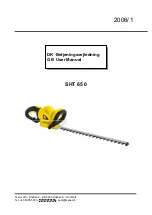
FUEL HANDLING
10 – English
Fuel safety
Never start the machine:
1
If you have spilt fuel on it. Wipe off the spillage and
allow remaining fuel to evaporate.
2
If you have spilt fuel on yourself or your clothes,
change your clothes. Wash any part of your body that
has come in contact with fuel. Use soap and water.
3
If the machine is leaking fuel. Check regularly for
leaks from the fuel cap and fuel lines.
Transport and storage
•
Store and transport the machine and fuel so that there
is no risk of any leakage or fumes coming into contact
with sparks or naked flames, for example, from
electrical machinery, electric motors, electrical relays/
switches or boilers.
•
When storing and transporting fuel always use
approved containers intended for this purpose.
•
When storing the machine for long periods the fuel
tank must be emptied. Contact your local petrol
station to find out where to dispose of excess fuel.
•
Ensure the machine is cleaned and that a complete
service is carried out before long-term storage.
•
The transport guard must always be fitted to the
cutting attachment when the machine is being
transported or in storage.
•
In order to prevent unintentional starting of the engine,
the spark plug cap must always be removed during
long-term storage, if the machine is not under close
supervision and when performing all service
measures.
Fuel
CAUTION!
The machine is equipped with a two-stroke
engine and must always been run using a mixture of
petrol and two-stroke engine oil. It is important to
accurately measure the amount of oil to be mixed to
ensure that the correct mixture is obtained. When mixing
small amounts of fuel, even small inaccuracies can
drastically affect the ratio of the mixture.
Petrol
CAUTION!
Always use a quality petrol/oil mixture at least
90 octane (RON). If your machine is equipped with a
catalytic converter (see chapter on Technical data) always
use a good quality unleaded petrol/oil mixture. Leaded
petrol will destroy the catalytic converter.
Use low-emission petrol, also known as alkylate petrol, if
it is available.
•
The lowest octane recommended is 90 (RON). If you
run the engine on a lower octane grade than 90 so-
called knocking can occur. This gives rise to a high
engine temperature, which can result in serious
engine damage.
•
When working at continuous high revs a higher octane
rating is recommended.
Two-stroke oil
•
For best results and performance use HUSQVARNA
two-stroke engine oil, which is specially formulated for
our air-cooled two-stroke engines.
•
Never use two-stroke oil intended for water-cooled
engines, sometimes referred to as outboard oil (rated
TCW).
•
Never use oil intended for four-stroke engines.
•
A poor oil quality and/or too high oil/fuel ratio may
jeopardise function and decrease the life time of
catalytic converters.
•
Mixing ratio
1:50 (2%) with HUSQVARNA two-stroke oil.
1:33 (3%) with oils class JASO FB or ISO EGB
formulated for air-cooled, two-stroke engines.
!
WARNING! Take care when handling fuel.
Bear in mind the risk of fire, explosion
and inhaling fumes.
!
WARNING! Fuel and fuel fumes are
highly inflammable and can cause
serious injury when inhaled or allowed to
come in contact with the skin. For this
reason observe caution when handling
fuel and make sure there is adequate
ventilation.
Petrol, litre
Two-stroke oil, litre
2% (1:50)
3% (1:33)
5
0,10
0,15
10
0,20
0,30
15
0,30
0,45
20
0,40
0,60
Содержание 325HS75 X-series
Страница 24: ......
Страница 25: ......
Страница 26: ......
Страница 27: ......
Страница 28: ...1151133 26 z S 6 z S 6 2008 03 11 ...











































